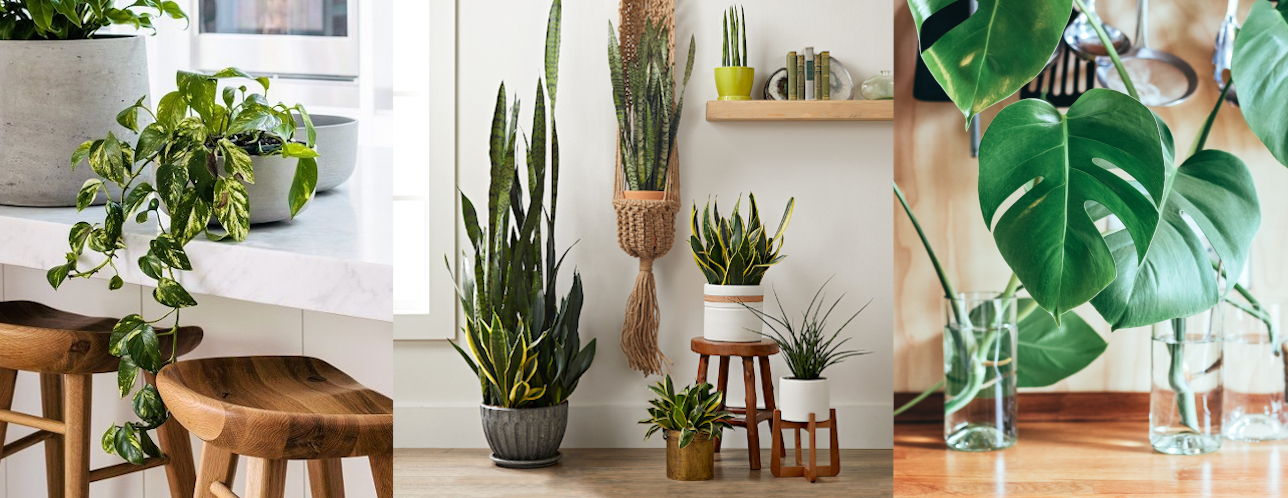We might never empathise, but our high-rise living quarters, a comfortable place of respite after gruelling work hours, is anything but a sanctuary for yet another living thing — plants. With the challenge of space constraints, lack of sufficient sunlight, and natural sources of water, a humble HDB flat is quite the tricky environment for most plants to survive, except the ones we’re recommending here, of course.
After all, who doesn’t get house envy when scrolling through Instagram and seeing these gorgeous homes on our feed, with just the right amount of greenery to make you feel at peace?

For this indoor plants guide, we reached out to Gardens by the Bay‘s Senior Horticulturist Muhammad Hazri Mohammad Siddiq, to get his expert advice on cultivating house plants suitable for our climate — particularly, hardy and low-maintenance ones that won’t die despite our ignorance or neglect.
As part of the attraction’s Stay Home content, the team of horticulturists responsible for their beautiful floral displays and garden landscapes, have come up with educational videos and even a Plant Doctor initiative, where interested members of the public can personally write in for plant advice. More on this in our Top Tips below.

First off, a word of encouragement from Hazri: “Gardening is not difficult if you choose the right plants for the conditions of your home. Beginner gardeners may have the tendency to pick plants based on their appearance, instead of choosing plants based on whether they can grow in the conditions specific to their home.” So there, pick your plant wisely if you want to see favourable results! These should include those tolerant of shady environments, and therefore suitable for homes in Singapore.
For those who’ve always wanted to exercise your green fingers, but never dared ventured forth because ‘plant murderer’ doesn’t look good on your resume, read on for our recommendations.
We’ve also grouped them into 4 categories — the super hardy ones, those with air purifying benefits, most aesthetically-pleasing, and desk plants.
HOUSE PLANTS
As a general rule: “A good plant parent doesn’t neglect their plants, but these plants are fairly unfussy as long as you give them the right requirements. They don’t like intense sunlight so keep them away from the direct rays of the sun. How to know when to water? The easiest way is putting 1/3 of your finger in to see if it’s still wet to touch. If it’s dry, it’s time to give your plant a drink.” — Hazri
The Super Hardy Plants
1. Money Plant (Epipremnum aureum)

Feng shui aside, this is a top pick for home plant beginners, for its ability to flourish despite difficult circumstances. The Money Plant, or Devil’s Ivy, can thrive in environments with medium to low light, and only requires watering once a week or less. “The money plant is a very adaptable plant that can grow well with or without bright light, and in soil or in a vase of water,” Hazri tells us. Its heart-shaped leaves and long, slender stems also looks particularly pretty cascading over a kitchen counter or hanging by a window, while it can even grow from mason jars or bottles for a unique touch.
caring instructions:
- Needs only partial sunlight
- Water every 7 – 10 days
Shop online at The Garden Store ($18).
2. ZZ Plant (Zamioculcas zamiifolia)

We’ve been told that ZZ plants are perfect for lazy plant parents — how apt of a name then! This tropical house plant, with glossy waxy leaves, should ideally be placed in moderate and medium light situations, and can survive weeks of watering neglect without withering thanks to its thick, fleshy roots and spongy stems. The plant naturally stores water in its root system, which therefore does not require frequent watering. We’re talking once every two or three weeks. The ZZ is also an effective air purifier, and in a NASA study, researchers found it specifically adept at removing toxins such as xylene, toluene, and benzene from the air.
caring instructions:
- Moderate, indirect sunlight
- Water once every two weeks
Shop online at IKEA ($19.90).
3. Monstera (Monstera deliciosa)

With its broad leaves and bright green foliage, the Monstera happens to be one of those plants you spot all over Instagram. You now know that they’re perfectly manageable to grow at home too! Firstly, it does not require direct sunlight and favours indirect sunlight, and secondly, it does well with just weekly watering, which makes it a very favourable piece, especially if you like that lush tropical aesthetic. However, the plants do need more space to grow, so think about placing this in the living room or as an anchor plant in any interior space.
caring instructions:
- Indirect sunlight
- Water weekly
Shop online at Noah Garden Centre ($40) or IKEA ($8.90).
4. Cornstalk Dracaena (Dracaena fragans)

Recommended by Hazri, we like the unique shape of the Cornstalk, since it resembles a mini palm tree, and can add some necessary height for visually interesting interiors. The tropical African evergreens usually grow as large potted plants, with long, narrow leaves at the top of its cane-like stems. While quite tolerant of neglect such as low light levels and lack of water, as with all plants, it may start looking unattractive then; the best rule to follow would be to check when the top layer of the soil is dry before watering.
caring instructions:
- Indirect sunlight, near window
- Water when the surface of the soil is completely dry
Shop online at Noah Garden Centre ($50.60).
5. Rubber Plant (Ficus elastica)

The deep green leaves of the Rubber Plant gives off a serious vibe that would look great in your study or for those with a more muted home aesthetic. That aside, this hardy medium-sized house plant actually prefers drier soil and shade; you can leave it in a shady part of your home, and only water once the top surface of the soil is completely dry, which is usually less than once a week. The plant is also useful in removing formaldehyde, carbon dioxide, and carbon monoxide from the air, particularly useful for newly renovated flats, or rooms that face busy expressways.
caring instructions:
- Can grow in dim light; leave in a shady part of your home
- Water when the surface of the soil is completely dry; do not overwater
Shop online at IKEA ($15.90).
Plants That Purify The Air
6. Mother-in-Law’s Tongue (Dracaena Trifasciata)

This honestly deserves a place under ‘super hardy plants’, as recommended by Hazri, but the very popular house plant has quite formidable air purifying capabilities too, so we’ve listed it here. First off, why is this so hyped about? Its stiff leaves that grow steadily upwards makes for a nice centrepiece, while the plant also sees a pleasing yellow border around the banded leaves, which adds subtle texture to any home environment. It can also withstand long periods without water — once a month is usually recommended — and is unfussy with light.
Now, on to cleaner air. The low-maintenance plant not only filters harmful oxides, pollutants, and formaldehyde from the air in the day, but is also one of the rare plants that converts carbon dioxide to oxygen at night — this makes it ideal for bedrooms, or anywhere in your home really.
caring instructions:
- Does well in low-light, but best to expose it to bright, indirect light
- Water once a month; keep the soil dry in between
Shop online at Far East Flora ($20.90).
7. Spider Plant (Chlorophytum comosum)

The long, dangling leaves of the Spider Plant, affectionately named after everyone’s most hated creepy-crawly, still has its fans for its easy-to-grow quality — we must say, those striped leaves can easily spruce up a minimalist space very well. A hardy plant, it does not require direct sunlight but does prefer moist but well-drained soil, so keep it so if you’d like your plant to thrive. Just as well, the spider plant also removes harmful xylene, toluene, and formaldehyde from your air, so consider them a sweet and inexpensive alternative to pricey air filters…
caring instructions:
- Bright, indirect sunlight
- Water well, they like moist but well-drained soil
Shop online at The Garden Store ($12.90).
Desk Plants
8. Aloe Vera

We all love the good old Aloe Vera for its beauty benefits — you can usually find it in skin-soothing salves, cleansers, and moisturisers, and balms that aid in sun damage relief, due to the anti-inflammatory nature of flesh of this desert succulent. Then again, don’t let the “desert” part fool you; the plant does not like direct sunlight and may get sunburnt as a result. Instead, place it in a still bright but indirectly-lit spot, and don’t worry too much about watering as this one only needs moisture when the soil is completely dry. The plant itself can grow pretty medium-sized, but you can always opt for a tiny succulent on your desk.
caring instructions:
- Bright, indirect sunlight
- Water deeply, but infrequently; about once a month or when soil is completely dry
Shop online at The Garden Store ($12).
9. Fittonia

This one’s known as the nerve plant, and it’s easy to see why; those cute leaves are perennially green and delicately veined in appearance, though don’t worry, this plant is tough to kill. You might recognise it as one of those terrarium plants, precisely because the low-growing creeper likes those conditions: indirect sunlight and high, constant humidity. The best place for this, then, could be your bathroom as shower mist will be greatly beneficial for it to thrive.
caring instructions:
- Keep away from strong sunlight; indirect sunlight or fluorescent lights
- Water well, they like moist and well-drained soil; high humidity preferred
Shop online at Noah Garden Centre ($6).
10. Air Plants (Tillandsia)

Those who love greenery without the mess of soil and pots, listen up — air plants may be your best bet. Tillandsia are commonly known as air plants, of which there are around 650 species in total, and are known for their ability to live entirely off of nutrients and moisture in the air. That’s right, they can thrive under artificial light and mainly require misting, so offices and your current work-from-home desk are actually ideal. Creative individuals would also enjoy housing them in all sorts of displays, including glassware, driftwood, stone, repurposed sea shells, and more.
caring instructions:
- Do not require soil to grow
- Can thrive under artificial light, good for offices
- Mist them with water once a week; or soak in water once a month
Shop online at Gardens by the Bay ($12) and A Tilly A Day (from $4).
Most Aesthetic
11. Fiddle Leaf Fig (Ficus lyrata)

To be fair, the Fiddle Leaf Fig Tree isn’t the easiest house plant to maintain, but we’d be remiss not to include this It-plant here, due to its immense popularity. With that disclaimer out of the way though, it’s hard to hate the pretty plant, with its majestic leaves fanned out just-so, but do pay attention to its needs.
First, choose a well-lit spot in your home that’s away from direct sunlight, and pro tip here, rotate the pot often so that the plant grows evenly. For how much you should water, following Hazri’s general instructions above should do it — only water when the top inch or two of the soil is dry, by sticking your finger in. If it feels damp, skip the water and check again later. With a bit more love, your plant / Instagram prop can flourish.
caring instructions:
- Difficulty: medium, not for plant beginners
- Bright, indirect sunlight
- Water when the top inch or two of the soil is dry; requires checking in
Shop online at Far East Flora (from $85.90).
12. Asparagus Fern (Asparagus aethiopicus)

Most of the hardy plants here honestly look quite the same after a while — either thick, waxy stems and leaves, or flat, heart-shaped leaves that fan out from the middle. Here, you’re looking at a more unusual pick. The Asparagus Fern has a fluffy, feathery foliage that provides an interesting contrast to your home furnishings, and yet, still remains quite a robust keeper. This plant prefers morning sun and bright indirect sunlight, as well as dappled shade, so place it close to an east-facing window, and water once or twice a week.
caring instructions:
- Prefers morning sun and bright, indirect light
- Water once or twice a week; do not let the soil dry out
Shop online at Chlorofeel ($12).
13. Peace Lily (Spathiphyllum)

On to flowering plants, to break up some of that evergreen appearance. With that, the Peace Lily is featured in lots of beginners’ lists since it’s one of the few flowers that can bloom indoors, and despite dim light. While that is the case, offering it partial sunlight by the window or balcony will do it plenty of favours too; these tend to produce more flowers and those lovely white spathes (a specialised leaf bract that looks like a flower) you’ll notice here. The small investment of time and effort you put in will also lead to cleaner air at home — the plant can filter pollutants such as benzene and formaldehyde.
caring instructions:
-
- Can survive in the shade but prefer indirect sunlight
- Water weekly or when the surface of the soil is almost dry, thoroughly
- Use suitable fertiliser for regular flowering
Shop online at The Garden Store ($15).
14. Flamingo Lily (Anthurium andraeanum)

The last house plant we’ve got here comes recommended by Hazri as well. We know it as the Anthurium, native to South America, though Flamingo Lily is quite a common name for the species too, which you’ll definitely recognise a mile away. Those bright red leaf bracts are that distinctive, while the plant’s flowers bloom all year round. Once again, bright and indirect sunlight is preferred, while the tropical plant does well in moist soil.
caring instructions:
-
- Bright, indirect sunlight
- Water well, they like moist and well-drained soil
Shop online at Candy Floriculture ($12).
TOP TIPS
Here, you’ll find Senior Horticulturist Hazri’s top tips for growing and maintaining plants at home.

1. Start Small
“Start small – don’t be too ambitious with your selection of plants. Try something easy like a money plant.”
2. Choose Foliage Plants
“Consider the kind of growing conditions a plant requires. It’s natural to pick plants that are pretty or exotic, but most flowering plants need plenty of sunlight to bloom. Instead, apartment-dwellers should choose plants more tolerant of shadier corners, and these tend to be foliage plants.”
3. A Common Misunderstanding: Plants Don’t Like Direct Sunlight
“That would definitely be the plant’s requirements. A lot of folks might think that a sun-loving cactus can appreciate a bright windowsill when it would prefer a full exposure of the sun. Likewise with shade-tolerant plants, where many think that they can do well in the dark corners of the room. We still have to remember that before these plants become house plants, they were wild plants that were growing in their own environment and habitat. It would be great if we could replicate those environments before thinking that they will adapt to ours.”
4. how to deal with Plant Pests and yellowing leaves
“I often get questions on yellowing leaves and pests. For the latter, this is more specifically the common ones, mealybugs and scale insects, which are usually described as “white lumps” and “brown bumps” respectively, that appear on infested plants. If the infestation isn’t too severe, you can use your nails or a blunt tool to gently scrape them off or spray white summer oil if there are too many pests.
Yellowing leaves can mean a lot of things but most of the time, it could be underwatering and overwatering. For that, you would need to adjust your watering schedule to suit the plant’s need.”
If in doubt, you may write in to plant.doctor@gardensbythebay.com.sg, which is personally answered by the team of experts at Gardens by the Bay.
5. Do All Your Research!
“Get to know and understand the plant you want to grow first. Just like if you were considering a pet, wouldn’t you do your research first before making the commitment? Plants are living things too, and deserve the same treatment.”











You must be logged in to post a comment.